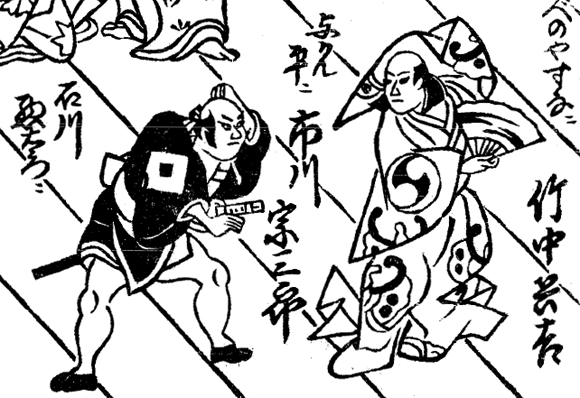| TAKENAKA HEIKICHI |
|
Stage name:
Poetry names: T˘getsu [4], Manchű [1] Existence: ??? ~ ??? Connection: Master: Takenaka Yaichi Career: Before 1718: son of Kojima Kozaemon and grandson of Tsuboya Ichibŕ, he was adopted by Takenaka Yaichi and received the name of Takenaka Heikichi. 1718: recorded for the first time in Ky˘to where he performed at Ebisuya Kichir˘bŕ's theater as an iroko. End of the 1710s or beginning of the 1720s: he performed for a while in Edo in kodomo shibai. 1732: Heikichi performed in Nagoya as a wakaonnagata. 11th lunar month of 1733: Heikichi played in ďsaka at the ďnishi no Shibai the role of the keisei Hanazuru in the kaomise drama "Shigeri Matsu Kogane no Takaragura", which was produced by Nakamura Jűz˘ I. 11th lunar month of 1734: Heikichi played at the ďnishi no Shibai the role of the keisei Michishiba in the kaomise drama "Asahi no Matsu Kogane no Shinbashira", which was produced by Nakamura Jűz˘ I. 11th lunar month of 1735: Heikichi played at the ďnishi no Shibai the role of Eitar˘'s mekake Fuseya in the kaomise drama "Momijigari Nishiki no Yomeiri", which was produced by Nakamura Jűz˘ I. Fall 1740: Heikichi settled in Ky˘to. 12th lunar month of 1740: Heikichi became tachiyaku and performed in the drama "Chinp˘ Sandai Gatana", which was produced by Sakakiyama Jűtar˘ I and starred Sakakiyama Koshir˘ I and Sakakiyama Shirotar˘ I. The title of this drama, literally "The Rare Treasure - Three Generations of Swords" [2], was an allusion to the three generations of actors of the Sakakiyama clan sharing the same stage. 11th lunar month of 1742: Heikichi performed in the kaomise drama "ďmi Genji Taihei no Kachidoki", which was produced by Hanakawa Ichinoj˘ at Hayagumo Ch˘dayű's theater. 1st lunar month of 1743: Heikichi played in the same theater the role of Soga Jűr˘ Sukenari in the ni-no-kawari new year drama "Harukoma Ikioi Soga" [3]; the roles of Kud˘ Saemon Suketsune and Soga Gor˘ Tokimune were played by Nakamura Utaemon I and Tsuuchi Monzabur˘ I. 11th lunar month of 1750: Heikichi played in Ky˘to at Ebisuya Kichir˘bŕ's theater the role of ďgiya Kisabŕ in Fujikawa Sakoku's kaomise drama "Taira no Miyako Onna Ez˘shi", which is produced by Sakakiyama Shirotar˘ II. 1st lunar month of 1751: Heikichi played in the same theater the role of the umakata Sankur˘, in reality Mashiba T˘z˘, in Fujikawa Sakoku's ni-no-kawari drama "Keisei Kane-ga-Fuchi". Fall 1752: Heikichi settled in ďsaka after 12 seasons spent in Ky˘to. 11th lunar month of 1752: Heikichi performed at the ďnishi no Shibai in the kaomise drama "Ky˘ Miyage Matsuri Zoroe"; his stage partners were Wakayama Shinkur˘, Wakayama Bunshichi, Yamamoto Ky˘shir˘ I, ďtani Hirohachi I, Matsushima Kiyosaki, Ichimura Sanohachi, Kirishima Gizaemon I, Kiriyama Monji I, Matsushima Moheiji, Murayama Heijűr˘ IV, Daimatsu Hyakusuke and Nakamura Shirogor˘ III. 1st lunar month of 1757: premiere at the ďnishi no Shibai of Namiki Sh˘z˘ I's drama "Tenjiku Tokubŕ Kikigaki ďrai"; Heikichi played the roles of the send˘ Matasaku and Hosokawa Katsumoto [casting]. 11th lunar month of 1761: Heikichi performed at the Naka no Shibai in the kaomise drama "Miyo no Hana Yunzei Kagami", which was produced by Mimasu Daigor˘ I. 12th lunar month of 1761: premiere at the Naka no Shibai of Takeda Haruz˘'s ni-no-kawari drama "Akiba Gongen Kaisen Banashi". It was the first drama in Kabuki history using gand˘-gaeshi on stage; Heikichi played the role of Matsukura Genmotsu [casting]. Fall 1763: Heikichi settled in Ky˘to after 11 seasons spent in ďsaka. 11th lunar month of 1763: Heikichi played at the Minamigawa no Shibai the roles of Ikoma Sh˘gen and his son Ikoma Gatajir˘ in Sakurato Bunsaku's kaomise drama "H˘raisan Hatsuhi no Kachidoki", which was produced by Arashi Matsunoj˘ III. He also played the role of Hanjimono no Kihŕ in the drama "Kurofune Deiri Minato". 1st lunar month of 1764: Heikichi's rank in the Ky˘to hy˘banki, tachiyaku section, was j˘-j˘-hankichi (superior - superior - half excellent) [visual]. Heikichi played in the same theater the role of Sakurai Shinbŕ in Namiki Sh˘z˘ I's ni-no-kawari drama "Keisei Hana no Shiroyama". 3rd lunar month of 1764: Heikichi's rank in the Ky˘to hy˘banki, tachiyaku section, was j˘-j˘-hankichi (superior - superior - half excellent) [visual]. No record afterwards. Comments: Takenaka Heikichi was born and trained in Ky˘to and Edo. He performed as a a href="glossaire_8.php#wakaonnagata">wakaonnagata from the 1st half of the 1730s to the beginnig of the 1740s, excelling in keisei roles. Then, he became a talented and popular tachiyaku for almost 24 seasons in both Ky˘to and ďsaka. He excelled in wagoto and jitsugoto. [2] It had also a different suggestive meaning because the word chinp˘ is the penis in old Japanese. [3] A sogamono as a ni-no-kawari was a rare treat in Kamigata! |
 |
|
Ichikawa S˘zabur˘ II (left) and Takenaka Heikichi (right) playing the roles of the yakko Yokanpei and Abe no Yasuna in the drama "Ashiya D˘man ďuchi Kagami", which was staged in the 10th lunar month of 1754 at the Kita-Shinchi no Shibai (Ësaka) |
|
|
| Contact | Main | Top | Updates | Actors | Plays | Playwrights | Programs | Links | FAQ | Glossary | Chronology | Illustrations | Prints | Characters | Derivatives | Theaters | Coming soon | News |